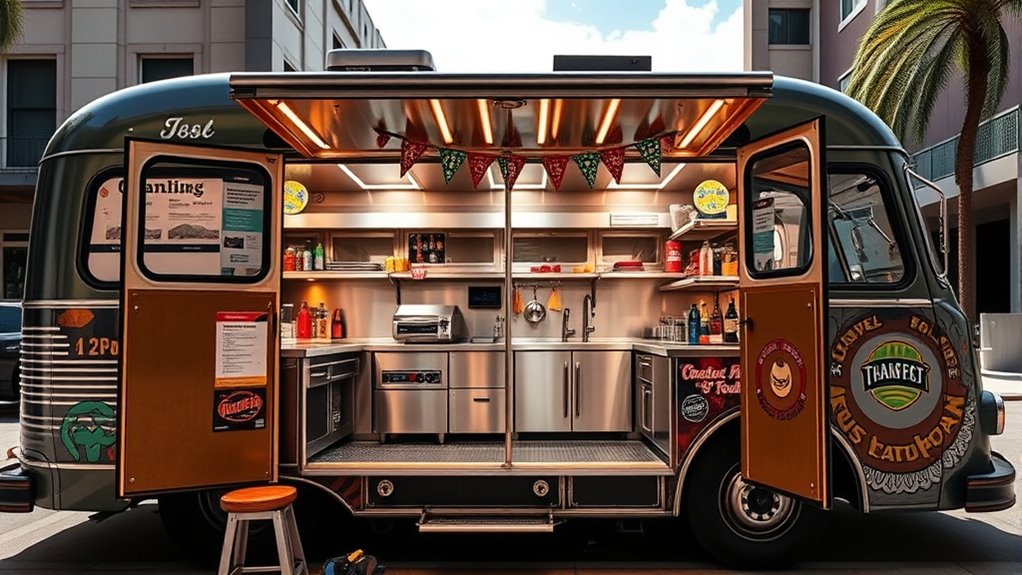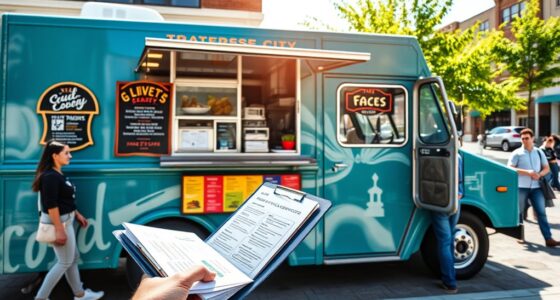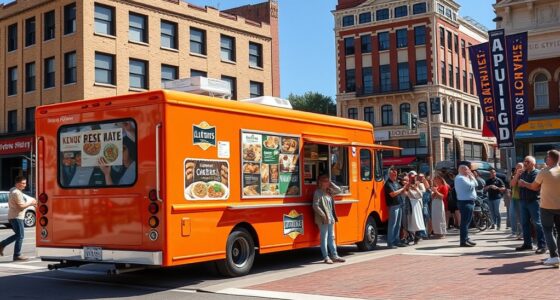To convert a bus or van into a food truck, start by evaluating if your vehicle is suitable and in good condition. Then, develop a detailed layout plan focusing on workspace and branding. Obtain all necessary permits and ensure you meet local safety and health regulations. Insulate and soundproof the interior, install ventilation, exhaust, plumbing, and electrical systems. Finally, add equipment, finish the interior, and conduct thorough testing. If you keep going, you’ll uncover all the key steps to make your food truck a success.
Key Takeaways
- Inspect and prepare the vehicle by addressing safety, structural integrity, and supporting systems like electrical and ventilation.
- Design an efficient layout optimizing space for workflow, appliances, storage, branding, and customer access.
- Obtain necessary permits and ensure compliance with local health, safety, and vehicle regulations.
- Install insulation, soundproofing, plumbing, electrical systems, and safety features to meet operational standards.
- Conduct final inspections, test all systems, and prepare the vehicle for launch and ongoing maintenance.
Assess Your Vehicle’s Suitability and Prepare It for Conversion

Before you begin converting your bus or van into a food truck, you need to evaluate whether the vehicle is suitable for the job. Start by inspecting its overall condition, focusing on vehicle maintenance and any potential repairs needed. Check the engine, brakes, tires, and suspension to ensure they’re in good shape. Safety inspections are essential to confirm the vehicle meets roadworthiness standards and is safe to operate daily. If your vehicle has rust, leaks, or structural issues, address those first. A thorough assessment helps you determine if the bus or van can handle the added weight and modifications. Ensuring your vehicle is reliable and safe is critical before moving forward with the conversion process. Additionally, considering the vehicle’s supporting systems such as electrical wiring and ventilation is vital to ensure they can support food service equipment effectively. Also, evaluating the material compatibility of your vehicle’s surfaces can prevent future issues with cleaning and durability. Conducting a system compatibility check can help identify potential challenges early in the process. Incorporating a comprehensive understanding of vehicle modifications can streamline your conversion and ensure compliance with safety standards. Consulting local regulations regarding food truck conversions can help you stay compliant with safety and health standards.
Develop a Detailed Design and Layout Plan
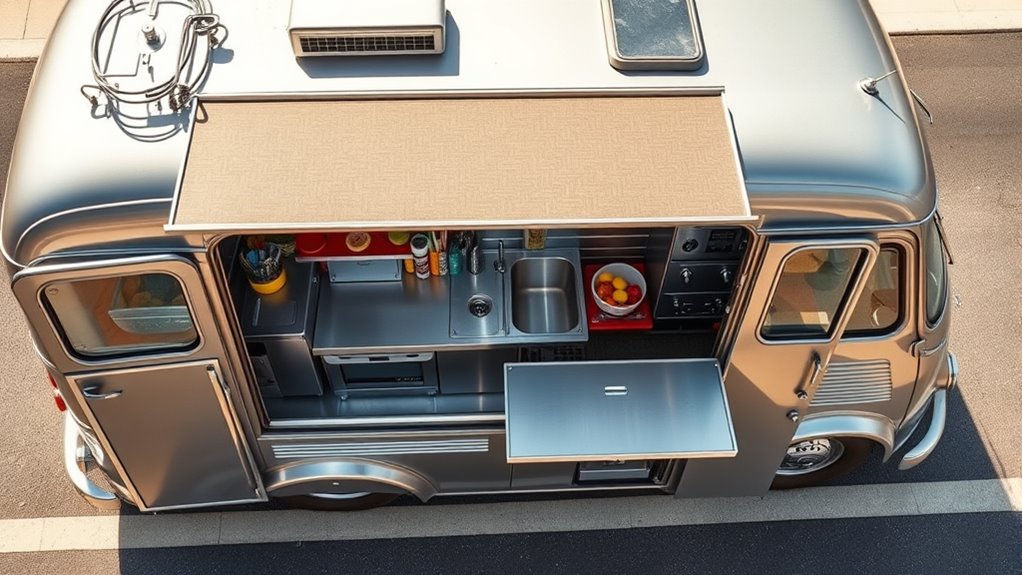
How do you create a functional and efficient layout for your food truck? Start by mapping out your workspace carefully, considering workflow and safety. Think about where to place appliances, prep stations, storage, and service windows to maximize efficiency. Incorporate your chosen color schemes to create a cohesive look that attracts customers and reflects your brand identity. Use branding graphics strategically on the exterior and interior to boost visibility and reinforce your brand. Keep in mind, the layout must comply with safety standards and allow smooth movement. Sketch your design multiple times, adjusting as needed to optimize space and functionality. A well-developed plan ensures your food truck operates smoothly, looks professional, and leaves a lasting impression. Additionally, understanding Self-Directed IRA and other investment options can influence your branding choices and storytelling, making your food truck more relatable and memorable to customers. Incorporating space optimization strategies can further enhance your layout’s efficiency and customer experience. Recognizing retail hours can help plan your operational schedule to match customer flow and peak times. Paying attention to vehicle dimensions and available power sources will also ensure your equipment fits properly and functions reliably during operation.
Obtain Necessary Permits and Comply With Regulations
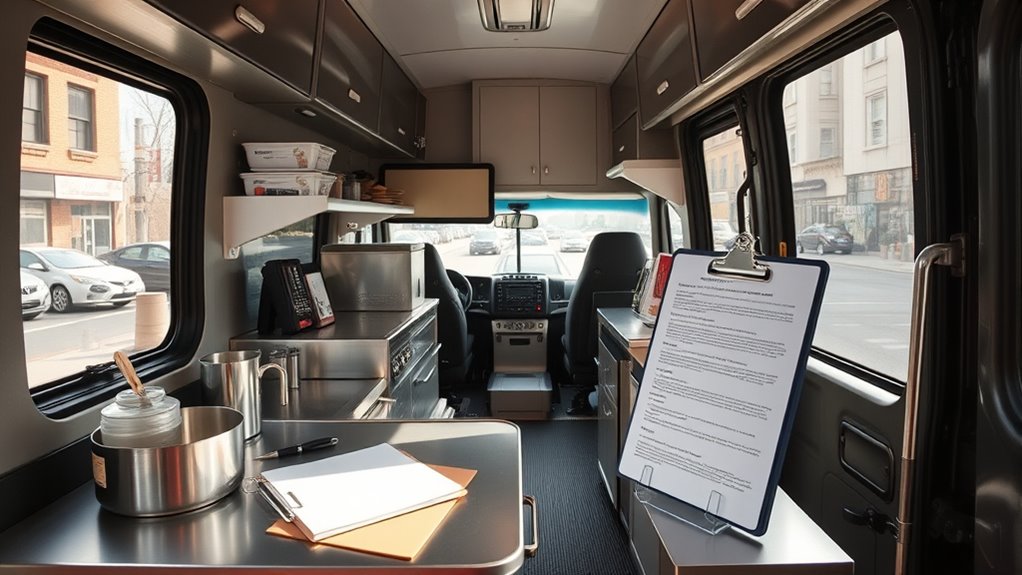
To get started, you need to understand the permitting process and which licenses are required for your food truck. You’ll also need to meet specific health and safety standards to operate legally. Making sure you comply with these regulations now will save you headaches later and keep your business running smoothly. Additionally, researching online resources for guidance can help streamline your application process and ensure you meet all legal requirements. Be aware that food safety standards are essential to prevent spoilage and ensure customer safety, which is critical in operating a successful food truck. Understanding regulatory compliance can also inform how you might incorporate entertainment into your business, attracting more customers and increasing engagement.
Permitting Process Overview
Guiding the permitting process is a crucial step in converting your vehicle into a food truck, and understanding what’s required can save you time and potential setbacks. Start by researching local, state, and federal regulations that govern food trucks. Obtain necessary permits like vehicle registration, food service licenses, and health department approvals. Keep in mind, proper permits guarantee compliance and protect your business legally. As you develop your vehicle branding and marketing strategies, consider how permits might impact your signage and promotional materials. Some jurisdictions require specific signage or branding to be approved. Staying organized and up-to-date with permit applications will streamline your transition. Ultimately, a clear understanding of these regulations helps you operate smoothly while building a strong, compliant foundation for your food truck venture.
Health and Safety Standards
Ensuring your food truck meets health and safety standards is essential for legal operation and customer trust. You must adhere to strict food safety protocols to prevent contamination and ensure your food is safe to eat. This involves maintaining sanitation standards by regularly cleaning and sanitizing all food contact surfaces, utensils, and equipment. You’ll need to follow local regulations regarding food handling and storage, such as proper refrigeration and labeling. Inspections from health departments verify that your truck complies with sanitation standards, so prepare for routine checks. Keeping detailed records of cleaning schedules, food temperatures, and staff training can help demonstrate your commitment to food safety. Proper equipment maintenance and cleanliness are vital to prevent issues like foodborne illnesses. Regular cleaning and food safety procedures not only keep your truck compliant but also demonstrate your dedication to customer well-being. Meeting these standards not only keeps you compliant but also builds confidence with your customers.
Insulate and Soundproof the Vehicle Interior
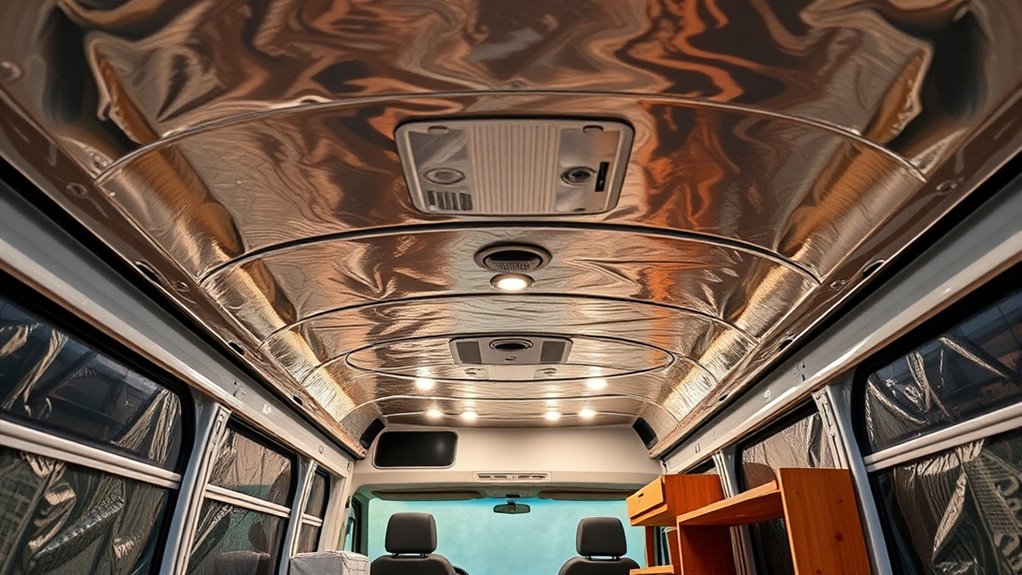
Choosing the right insulation material is key to maintaining temperature and reducing noise inside your food truck. You’ll also want to explore soundproofing techniques that block out external noise and keep your workspace quiet. Together, these steps guarantee a comfortable and efficient environment for your culinary operations. Incorporating soundproofing techniques can further enhance the noise reduction and overall comfort of your food truck interior. Additionally, understanding the role of attention during installation can help ensure your insulation and soundproofing efforts are most effective. Selecting materials with soundproofing properties can optimize your efforts and improve overall noise control. Being mindful of behavior patterns during installation can prevent common mistakes and ensure long-lasting results. Paying close attention to aura dynamics can also help identify areas needing better insulation and soundproofing for optimal comfort.
Insulation Material Choices
When selecting insulation for your food truck, it is essential to focus on materials that provide effective thermal and soundproofing qualities while being easy to install. Look for options that include thermal barriers to maintain temperature control and moisture barriers to prevent mold and rust. The right choice guarantees comfort, safety, and durability for your vehicle interior. Consider these key points: – Choose insulation with high R-value for better thermal resistance. – Prioritize materials resistant to moisture to avoid mold issues. – Opt for lightweight options that won’t add unnecessary weight or complicate installation. Additionally, selecting eco-friendly options often made from sustainable materials can contribute to a more environmentally conscious operation. Ensuring that your insulation setup includes effective filtration and pump protection can also help maintain the integrity of your vehicle’s systems over time. Incorporating insulation materials that are fire-resistant can further enhance safety standards for your food truck.
Soundproofing Techniques
To effectively soundproof your food truck’s interior, start by selecting materials that absorb noise and reduce vibrations. Acoustic barriers, like mass-loaded vinyl or specialized foam panels, block sound transmission, preventing noise from escaping or entering. For sound absorption, use dense insulation materials such as mineral wool or acoustic foam, which dampen vibrations and decrease echo inside the vehicle. Applying these materials to walls, ceilings, and floors creates a quieter environment, essential for customer comfort and compliance with noise regulations. Proper sealing of gaps and joints also helps prevent sound leakage. By combining acoustic barriers with effective sound absorption techniques, you’ll considerably minimize noise pollution and ensure your food truck operates smoothly and discreetly.
Install Ventilation, Exhaust, and Safety Systems
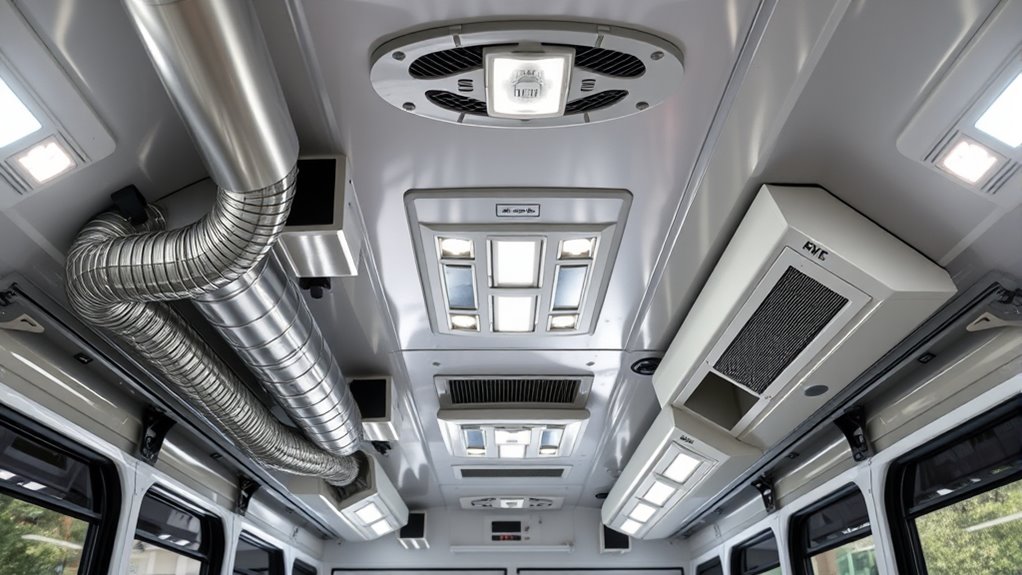
Installing proper ventilation, exhaust, and safety systems is essential to guarantee a safe and efficient food truck operation. Good ventilation systems help remove heat, smoke, and odors, ensuring a comfortable workspace and compliance with health standards. Exhaust systems vent out dangerous fumes and prevent buildup of grease, reducing fire risks. Safety protocols must be integrated to protect you and your staff, including fire extinguishers and gas leak detectors.
Proper ventilation and safety systems are vital for safe, compliant, and efficient food truck operations.
- Ensure your ventilation systems are properly rated for your cooking equipment.
- Regularly inspect and maintain exhaust systems to prevent grease buildup.
- Follow strict safety protocols, like proper fire suppression and gas line checks, to avoid accidents.
Set Up Plumbing and Electrical Systems
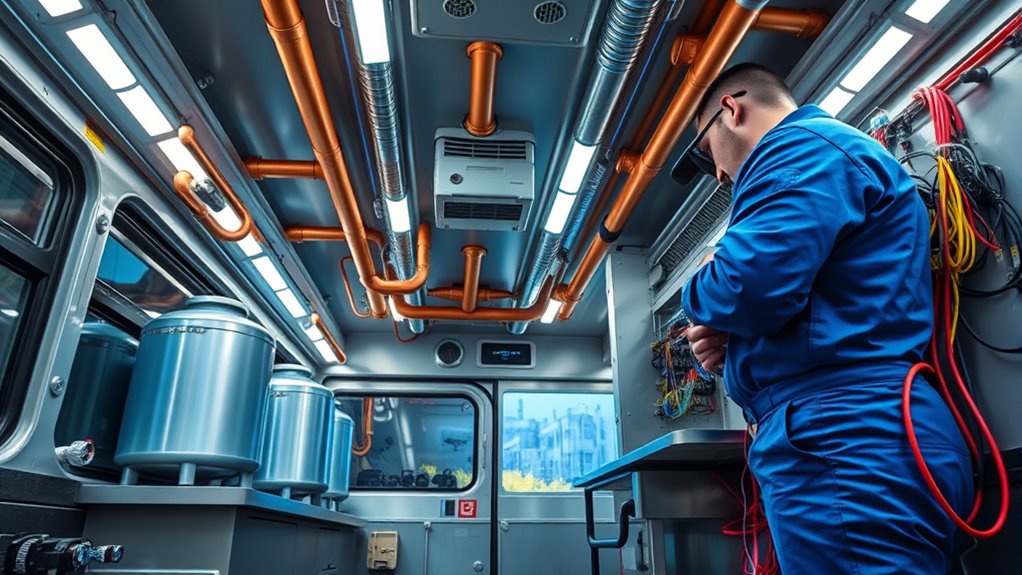
Setting up the plumbing and electrical systems is a critical step to guarantee your food truck operates smoothly and safely. You’ll need a reliable water supply system, connecting tanks and pumps to ensure consistent water flow. Proper electrical wiring is essential for powering lights, appliances, and equipment. Before starting, plan your water lines carefully to prevent leaks and contamination. Use water-safe pipes and secure connections. For electrical wiring, install a circuit breaker panel and route wires safely to avoid shorts or fires. Proper grounding and insulation are crucial. Below is a quick reference:
| System | Key Components | Tips |
|---|---|---|
| Water Supply | Tanks, pumps, water-safe pipes | Check for leaks, maintain sanitation |
| Electrical Wiring | Circuit panel, wiring, outlets | Ensure proper grounding, avoid overloads |
| Safety Measures | Fuses, circuit breakers | Protect against electrical hazards |
Install Cooking Equipment and Storage Solutions

Once you’ve prepared the electrical and plumbing systems, it’s time to focus on installing your cooking equipment and storage solutions. You’ll need to carefully select and position kitchen appliances that suit your menu, ensuring they fit safely and efficiently within your space. Proper storage solutions are essential to keep ingredients organized and accessible while maintaining a clean environment. Consider installing shelving, cabinets, or drawers tailored to your needs, maximizing every inch of your vehicle.
- Prioritize safety and accessibility when placing kitchen appliances
- Use versatile storage solutions to optimize space and function
- Plan for ventilation and ease of cleaning to maintain hygiene
Finish Interior Work: Finishing Touches and Branding
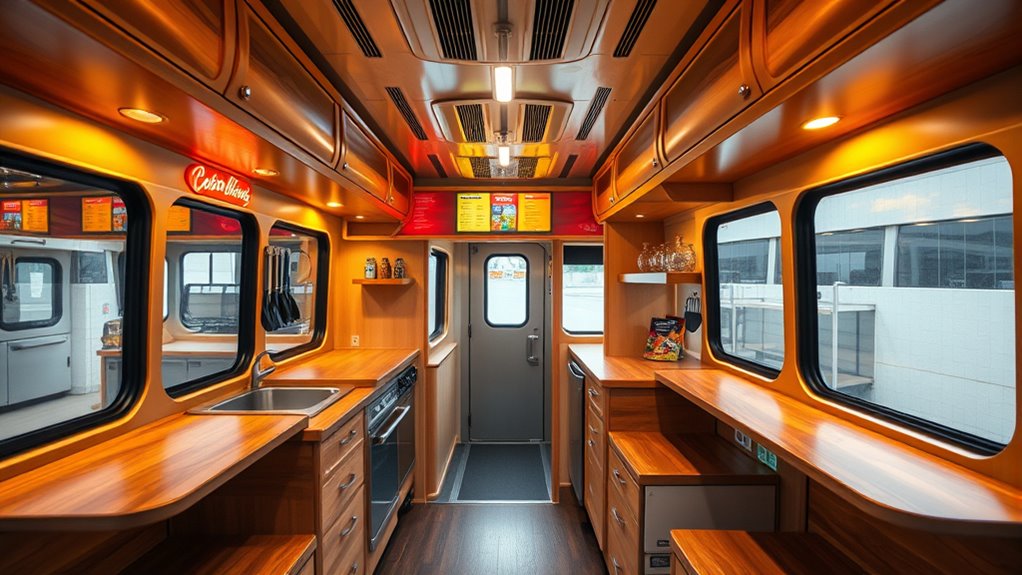
After installing your cooking equipment and organizing storage, it’s time to focus on finishing the interior with personal touches and branding elements. Add decorative accents like colorful wall art, custom signage, or themed decor to create a welcoming atmosphere. These touches give your food truck personality and help attract customers. Incorporate branding graphics throughout the space, such as logo decals, vehicle wraps, or custom murals, to reinforce your brand identity. Make certain these elements are consistent with your overall branding strategy, making your truck instantly recognizable. Keep the interior clean and functional, but don’t forget to infuse it with style. These finishing touches not only enhance your food truck’s aesthetic appeal but also set the stage for a memorable customer experience.
Conduct Testing and Final Inspection Before Launch

Before launching your food truck, it’s essential to conduct thorough testing and a final inspection to guarantee everything functions smoothly. Check the vehicle maintenance details, such as brakes, tires, and engine performance, to prevent breakdowns. Test all electrical systems, including lighting and appliances, for safety and reliability. Evaluate fuel efficiency by monitoring how the vehicle performs under load, which helps manage operating costs.
Conduct thorough inspections and test all systems to ensure your food truck operates safely and efficiently.
- Verify that all safety features are in place and operational
- Conduct a test drive to identify any mechanical issues
- Confirm that your vehicle’s fuel consumption aligns with expectations
Frequently Asked Questions
How Much Does Converting a Vehicle Into a Food Truck Typically Cost?
Converting a vehicle into a food truck usually costs between $20,000 and $100,000, depending on size and customization. You’ll need to factor in vehicle branding to make your truck stand out, which can add to costs. Insurance costs also vary based on coverage and location. Keep in mind, costs can fluctuate based on your specific setup, so it’s wise to budget for unexpected expenses as well.
What Are the Most Common Challenges Faced During Conversion?
When you face challenges during conversion, equipment selection can be tricky, making sure everything fits and functions properly. Permitting processes often slow you down, as you navigate regulations and inspections. You might also encounter issues with limited space, electrical systems, or plumbing. Staying organized and researching requirements ahead of time helps you tackle these common obstacles efficiently, ensuring a smoother progression from vehicle to fully operational food truck.
How Long Does the Entire Conversion Process Usually Take?
The conversion timeline varies based on your project’s complexity, but typically, it takes anywhere from 4 to 8 weeks. You’ll want to hit key production milestones, like designing the layout, installing equipment, and finishing touches, to stay on schedule. Keep in mind, delays can happen, so plan for some flexibility. Staying organized and working with experienced professionals helps make certain your food truck conversion stays on track.
Are There Specific Vehicles Better Suited for Food Truck Conversion?
Think of your vehicle as the foundation of your culinary empire. You’ll want a vehicle with the right size—large enough to fit all your equipment but manageable for city driving. Consider engine type too; a reliable, fuel-efficient engine makes daily operations smoother. Vans are often ideal because they’re versatile and easier to convert, while larger vehicles like buses require more work but offer extra space. Choose wisely to set your food truck up for success.
What Are the Ongoing Maintenance Requirements After Conversion?
After your food truck conversion, you need to keep it running smoothly with regular maintenance. Follow cleaning routines to prevent buildup and guarantee hygiene standards. Check your equipment regularly for any signs of wear or malfunction, like grills or refrigeration units. Staying on top of these tasks prevents costly repairs and keeps your business running efficiently. Consistent maintenance not only prolongs your food truck’s lifespan but also helps you serve safe, high-quality food.
Conclusion
Turning your vehicle into a food truck transforms more than just a space—it becomes a mobile dream. The journey from blueprint to bustling kitchen is filled with challenges, but the joy of serving your community makes every step worthwhile. With patience and passion, you’ll create a unique spot on wheels, blending hard work with heartfelt flavor. In the end, it’s not just about food; it’s about turning your vision into a vibrant, moving masterpiece.
